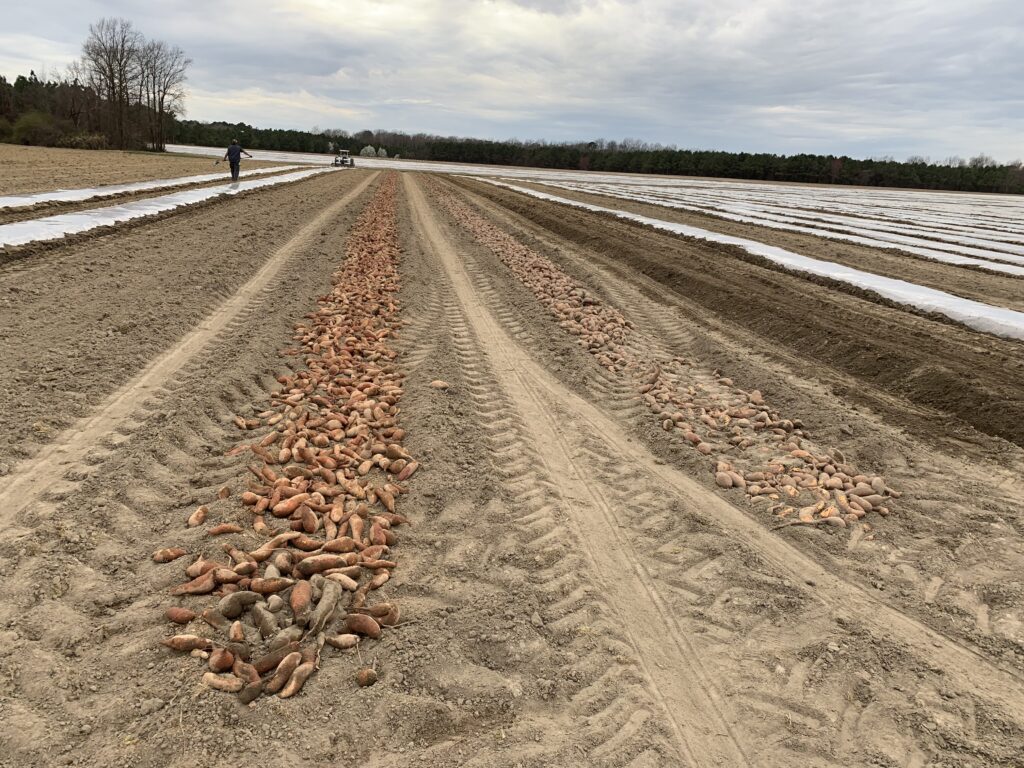All About Sweetpotatoes
go.ncsu.edu/readext?846318
en Español / em Português
El inglés es el idioma de control de esta página. En la medida en que haya algún conflicto entre la traducción al inglés y la traducción, el inglés prevalece.
Al hacer clic en el enlace de traducción se activa un servicio de traducción gratuito para convertir la página al español. Al igual que con cualquier traducción por Internet, la conversión no es sensible al contexto y puede que no traduzca el texto en su significado original. NC State Extension no garantiza la exactitud del texto traducido. Por favor, tenga en cuenta que algunas aplicaciones y/o servicios pueden no funcionar como se espera cuando se traducen.
Português
Inglês é o idioma de controle desta página. Na medida que haja algum conflito entre o texto original em Inglês e a tradução, o Inglês prevalece.
Ao clicar no link de tradução, um serviço gratuito de tradução será ativado para converter a página para o Português. Como em qualquer tradução pela internet, a conversão não é sensivel ao contexto e pode não ocorrer a tradução para o significado orginal. O serviço de Extensão da Carolina do Norte (NC State Extension) não garante a exatidão do texto traduzido. Por favor, observe que algumas funções ou serviços podem não funcionar como esperado após a tradução.
English
English is the controlling language of this page. To the extent there is any conflict between the English text and the translation, English controls.
Clicking on the translation link activates a free translation service to convert the page to Spanish. As with any Internet translation, the conversion is not context-sensitive and may not translate the text to its original meaning. NC State Extension does not guarantee the accuracy of the translated text. Please note that some applications and/or services may not function as expected when translated.
Collapse ▲Did you know sweetpotatoes are the state vegetable of North Carolina, and that our state grows about 60% of the sweetpotatoes grown in the US? These are just two facts about sweetpotatoes that children in Sampson County are currently learning through our Extension Ag in the Classroom program, sponsored by NC Farm Bureau and Sampson County United Way. Today I wanted to share some facts and trivia about sweetpotatoes that our youth are learning, that some of you may not know.
- Sweetpotato is written as one word. Sweetpotatoes are storage roots, where white potatoes are tubers. Sweetpotatoes are in the morning glory plant family, with the flowers and stems growing above the ground, with the storage root (potato) growing from one sprout underground in groups, called a hill.
- A yam is not a sweetpotato. The names have been interchanged for years, but they are different! Sweetpotatoes got called yams years ago, but in reality they are very different plants. 95% of yams are grown in Africa with rough, scaly skin, and low in beta carotene, which is the opposite for a sweetpotato. Yams are not very sweet and more potato-like (starchy). Both are very nutritious, but sweetpotatoes have more sugar, protein, calcium, iron, sodium, beta-carotene, and moisture. Yams are a cream color while sweetpotatoes can be many colors, such as orange, white, pink, red or purple.
- Sweetpotatoes are not grown from seeds, but are grown from young plants called sprouts or slips. The slips are grown from whole “seed potatoes” placed on top of the ground, covered by soil and plastic, or grown in a greenhouse. These young plants are then transplanted in May to the field in rows by workers and a machine called a setter.
- It takes 90-120 days without frost for sweetpotatoes to grow. They are harvested from August to October, then graded, sorted, and cured.
- After curing sweetpotatoes for 4-7 days at 80-85 degrees F, and 80-90% relative humidity, which changes starch in them to sugar for their sweet taste, farmers store sweetpotatoes in a climate controlled, well-ventilated building at 55-60 degrees and 85% relative humidity. They can be stored in this environment all year for us to enjoy!
- We should store sweetpotatoes in a cool, dry, place, away from heat, but not in the refrigerator. Storing in the refrigerator will cause poor taste and a hard center.
- Sweetpotatoes can be eaten raw or cooked. There are many ways to serve our state vegetable, and several great recipes can be found at the NC Sweetpotato Commission website, at ncsweetpotatoes.com.
- A medium sweetpotato is about 100 calories and is a good source of vitamins A, C, and E, as well as Iron and Calcium.
Hopefully now you know a little more about our state vegetable! To learn more about sweetpotatoes or our Ag in the Classroom program in Sampson County, feel free call us at the Extension Center at 910-592-7161 or visit us at https://sampson.ces.ncsu.edu/.
Information in this article was compiled from the North Carolina Sweetpotato Commission and the NCDA Farm to School Program.




